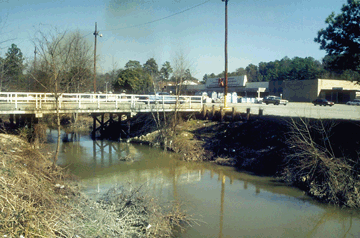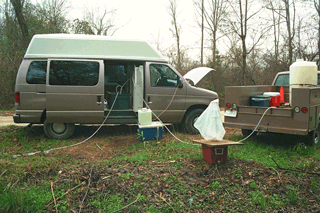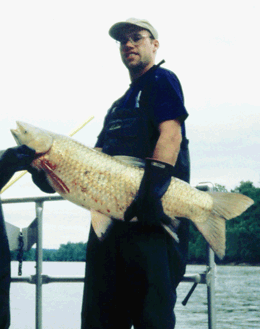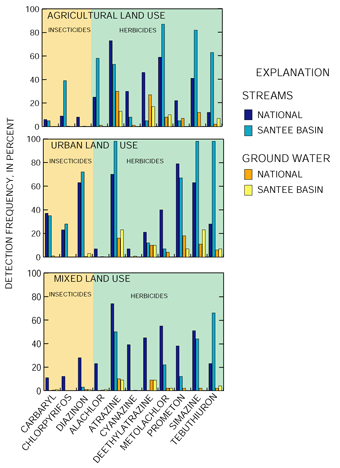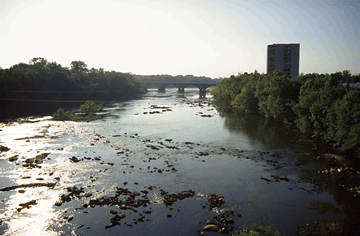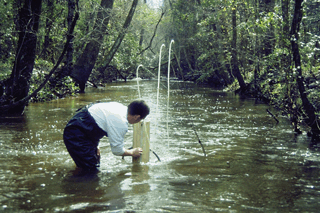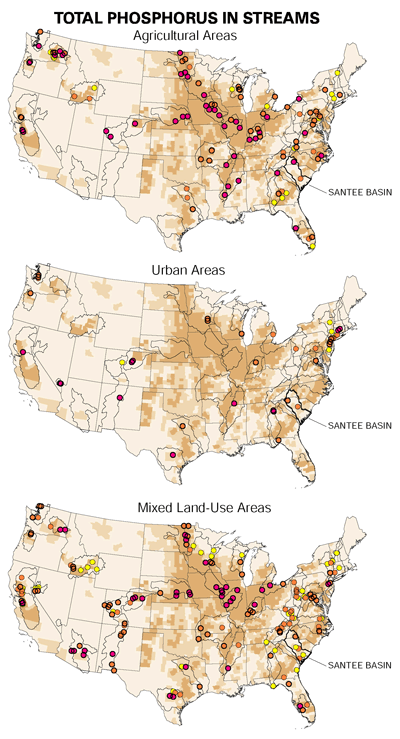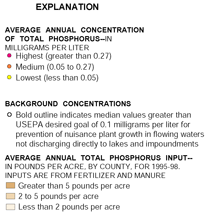MAJOR FINDINGS
Pesticides Commonly Were Detected in Santee Basin Streams
Thirty pesticides, including 22 herbicides and 8 insecticides, were detected in streams in the Santee Basin (Maluk and Kelley, 1998). Of the 161 surface-water samples collected, 141 contained at least one pesticide. At least one pesticide was detected at all of the sites, including forested sites that have little influence from humans.
Although detections were frequent, concentrations tended to be low, with no herbicides and only four insecticides and one metabolite exceeding aquatic-life criteria. None of the pesticide concentrations exceeded drinking-water standards. Thirteen of the 30 pesticides detected do not have aquatic criteria and 7 do not have drinking-water standards (U.S. Environmental Protection Agency, 1996).
|
|
| Insecticides were detected most frequently in urban streams, such as Gills Creek in Columbia, S.C. |
Herbicides were the most commonly detected pesticides in streams. Atrazine, an herbicide used on corn as well as turfgrasses and golf courses, was detected at the most sites, occurring at 11 of the 13 sampling sites. Other frequently detected herbicides were simazine, metolachlor, and prometon.Tebuthiuron, an herbicide that generally is used to control weeds on highway and railroad rights-of-way, also was detected frequently.
Insecticides were detected much less frequently than herbicides, accounting for less than one-third of the pesticides detected. Most insecticides detected are used on agricultural and ornamental crops, lawns, livestock, and in homes and gardens. Those most commonly detected included chlorpyrifos, diazinon, malathion, and carbaryl.
Urban Streams Contain More Pesticides than Other Streams
Pesticides were detected more frequently in urban streams than in agricultural streams (fig. 5). The most commonly detected herbicides—simazine, prometon, atrazine, and tebuthiuron—were detected nearly twice as frequently in water samples collected at urban sites than at agricultural sites. Conversely, some herbicides such as metolachlor and alachlor were detected almost exclusively at agricultural sites.
Insecticides were detected about four times more frequently at urban stream sites than at agricultural stream sites, and aquatic-life criteria were exceeded in nine samples collected at urban sites and in three samples collected at agricultural sites. The insecticide diazinon was detected only in urban streams, whereas chlorpyrifos was detected frequently in both urban and agricultural streams. This agrees with national findings in which insecticides were detected more frequently in urban than in agricultural streams (U.S. Geological Survey, 1999).
These findings indicate that while agricultural activities contribute pesticides to surface water, concentrations are rarely high enough to affect aquatic life. The consequences of urban and suburban use of pesticides is much more significant, with concentrations of insecticides frequently at levels that can affect aquatic life.
 |
| Figure 5. Pesticides, particularly insecticides, were detected more frequently in urban streams than in agricultural streams. |
Pesticides Showed Seasonal Patterns in Streams
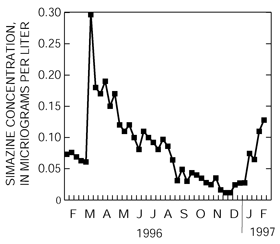 |
| Figure 6. Herbicide concentrations generally peaked following spring applications in Gills Creek, an urban stream. |
Some herbicides showed patterns of occurrence that can be related to seasonal applications and weather patterns. At Gills Creek, an urban stream, concentrations of herbicides, such as atrazine, simazine, and tebuthiuron, peaked in the spring following application and gradually decreased over the summer (fig. 6). Atrazine and simazine followed a similar pattern at Cow Castle Creek, an agricultural stream, with the addition of a second peak in early fall. The highest concentrations at all sites were observed during storms that followed applications.
Understanding these patterns of occurrence is important because sampling programs need to be designed so that critical periods of high pesticide concentrations are monitored. This information also can be used by environmental managers to assess risk associated with agricultural chemical use.
Few Pesticides Were Detected in Drinking-Water Supply Aquifers
|
|
|
| Ground-water samples are pumped directly into a mobile laboratory for processing samples and conducting field analyses. |
Of the 90 drinking-water, industrial, and irrigation supply wells sampled in the Floridan, Piedmont, and Sandhills aquifers, 17 had detectable concentrations of pesticides; of those, only two wells had pesticide concentrations that exceeded USEPA drinking-water standards (U.S. Environmental Protection Agency, 1996). Eleven of the 34 pesticides detected in drinking-water supply aquifers did not have water-quality standards.
The Sandhills aquifers are more susceptible to contamination than the other aquifers, as is illustrated by the larger number of pesticides detected and the higher detection frequency in the Sandhills aquifers than in the Piedmont and Floridan aquifers (fig.7). In addition, the two wells that had pesticide concentrations exceeding USEPA drinking-water standards were located in the Sandhills aquifers. Drinking water obtained from the Piedmont and Floridan aquifers is probably unlikely to contain pesticides at harmful levels; however, the high rate of detection and large number of pesticides detected in the Sandhills aquifers are a cause for concern.
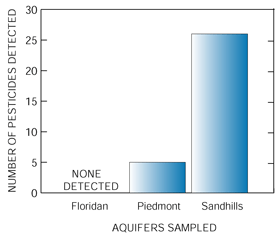 |
| Figure 7. The large number of pesticides detected in the Sandhills aquifers illustrates its relatively high susceptibility to contamination. |
The differences in the rate and number of detections
in the aquifers may be related to differences in aquifer properties. The
Sandhills are largely composed of layers of coarse and fine sand with
various quantities of clay. No continuous confining unit or soil layer
overlies the aquifer to impede the movement of contaminants into ground
water. At the other extreme, the Floridan aquifer has an overlying clay
confining layer that impedes vertical movement of contaminants throughout
much of its extent (Aucott and others, 1987). The Piedmont aquifer has
an overlying layer of weathered bedrock that contains abundant clay. The
thickness of this unit is highly variable, but generally it impedes rapid
vertical movement of contaminants from land surface to ground water.
Pesticides Were Common in Shallow Ground Water in Urban and Agricultural Areas
Pesticides were detected in 24 of 30 shallow wells in urban areas and in 22 of 30 wells in agricultural areas (Reuber, 1999). Dieldrin concentrations exceeded drinking-water standards in four urban wells; however, the wells sampled were installed for monitoring purposes only and are not drinking-water supply wells. Dieldrin also exceeded aquatic-life standards in these four urban wells, and tebuthiuron concentrations exceeded aquatic-life standards in one agricultural well. Generally, ground-water concentrations are not compared to aquatic-life standards; however, these concentrations can be of concern because shallow ground water can discharge to streams, elevating the pesticide concentrations in surface water.
|
|
| Shallow wells for the urban ground-water study were installed by the U.S. Geological Survey with assistance from the South Carolina Geological Survey. |
Pesticides were detected in ground water in urban areas about twice as frequently as in agricultural areas (fig. 8). Some pesticides detected in urban and agricultural ground water were the same, although insecticides were detected more frequently in urban ground water. This was similar to national NAWQA findings. The insecticide most frequently detected at urban sites was dieldrin. Although its agricultural use was canceled in the mid-1970s, dieldrin (and aldrin, which breaks down to dieldrin) was used for termite control until the mid-1980s and is a persistent compound (Barbash and Resek, 1996). Dieldrin was also the most commonly detected pesticide in urban ground water nationally (U.S. Geological Survey, 1999).
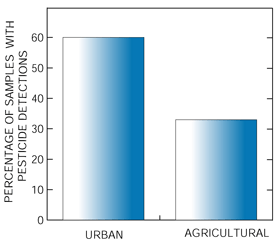 |
| Figure 8. Pesticides were detected more frequently at urban ground-water sites than at agricultural sites. |
Organochlorine Pesticides Were Detected in Bed Sediment and Tissues
Fourteen pesticides were detected in streambed-sediment samples, and 21 of 24 sites sampled had at least one detectable pesticide. All of the pesticides detected in sediment were organochlorine insecticides, such as chlordane, dieldrin, mirex, and DDT and its derivatives. Many of these compounds had their agricultural uses cancelled more than 20 years ago, yet they still appear in sediment samples. The reason for this is because the compounds are persistent, or are highly resistant to chemical breakdown.
Of the compounds detected, only DDE, a breakdown product of DDT, exceeded guidelines for the protection of aquatic life. The guidelines were exceeded at three sites, all of which are in basins with a high percentage of agricultural land. In addition, DDT concentrations were only slightly below the aquatic guidelines at several sites. Comparisons of land use to concentrations of organochlorine pesticides generally did not show strong relations, primarily because these insecticides were used in both urban and agricultural settings (fig. 9). The only prominent relation is the uniformly low levels of these pesticides detected at forested sites where these chemicals were less likely to be used.
|
|
|
| Organochlorine pesticides, such as DDT, can be found in streambed sediment and can accumulate in tissues of fish, such as this carp. |
The same pesticides detected in sediments were also in clam and fish tissues. Concentrations measured were generally much higher in tissue than in sediment; however, a direct comparison of these concentrations may not be valid because of potential differences in exposure rates of sediment and fish, differences in uptake by sediment organic carbon and tissue, and partitioning in fish tissue.
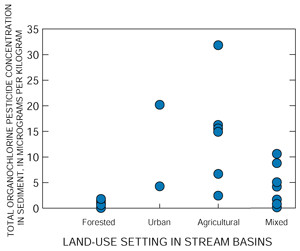 |
| Figure 9. Bed sediment in forested settings has significantly lower total organochlorine pesticide concentrations than bed sediment in other land-use settings. |
The most common pesticides detected in the Santee Basin included atrazine, simazine, tebuthiuron, prometon, and metolachlor. These pesticides were among the top 11 pesticides detected nationally. Consistent with national findings, herbicides were the most common type of pesticide detected in streams and aquifers in agricultural areas in the Santee Basin, whereas insecticides were more prevalent in urban areas. Overall, streams and aquifers that integrate different land uses had lower concentrations of pesticides than those that are dominated by either agricultural or urban land uses. Detections of pesticides in mixed land-use streams in the Santee Basin overall were much less frequent than national detections. The most striking differences between national and Santee Basin findings are the more frequent detections of alachlor, diazinon, and metolachlor in agricultural streams, simazine in agricultural and urban streams, and tebuthiuron in all land-use settings in the Santee Basin. The greater detection frequency does not appear to result from higher use of these compounds in the Santee Basin. |
Phosphorus Concentrations in Streams Frequently Exceeded USEPA Goals
Nutrients measured in streams in the Santee Basin, such as ammonia, nitrite, nitrate, phosphate, and orthophosphate, were elevated above background concentrations in areas affected by agricultural and urban runoff. Of these nutrients, the only one governed by a drinking-water standard is nitrite-plus-nitrate nitrogen (hereinafter referred to as nitrate) because it is the only nutrient that directly affects human health. None of the surface-water samples had concentrations of nitrate that were above the drinking-water standard of 10 milligrams per liter (mg/L) (U.S. Environmental Protection Agency, 1996).
Phosphorus concentrations were above the USEPA goal in several rivers in the Santee Basin. For example, the flow-weighted mean annual concentration of total phosphorus in the South Fork Catawba River is about four times higher than the USEPA goal for streams entering a reservoir (U.S. Environmental Protection Agency, 1986) (fig. 10). This is important because many of the reservoirs in the Santee Basin are eutrophic; that is, they have high levels of nutrients that can result in excessive growth of algae (Stecker and Crocker, 1991). Much of the phosphorus and nitrogen that feeds the algae is carried into the reservoirs by major rivers. The South Fork Catawba River flows into Lake Wylie directly downstream of the sampling site and is the only stream sampled that enters directly into a reservoir.
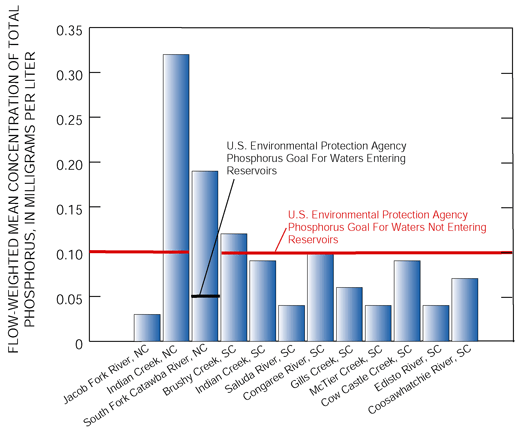 |
| Figure 10. Three streams in the Santee Basin frequently exceeded the U.S. Environmental Protection Agency goal for phosphorus in surface waters not entering reservoirs, and one exceeded the goal for waters entering reservoirs. |
|
|
| The Congaree River is one of several rivers in the Santee Basin that exceeded the U.S. Environmental Protection Agency goal for phosphorus. |
The USEPA also has a goal of 0.1 mg/L total phosphorus for streams that do not directly discharge to reservoirs (U.S. Environmental Protection Agency, 1986). The purpose of this goal is to prevent excessive plant growth in streams. Indian Creek, N.C., Congaree River, and Brushy Creek do not meet this goal based on mean annual concentrations (fig. 10). Only two of the streams sampled did not have at least one sample above the goal. These were Jacob Fork River and McTier Creek, both of which drain forested watersheds. The remaining streams had percentages of individual samples that exceeded the goal, ranging from 4 to 96 percent.
An analysis of nutrient data collected by State monitoring agencies during 1973–93 (Maluk and others, 1998) showed that all but 3 of 90 stream and lake sites exceeded the applicable phosphorus goal at least once, and 23 sites had median concentrations that exceeded the goal. Although 34 of the 90 sites showed decreasing trends in phosphorus concentrations, 53 showed no trend, and 3 had increasing trends.
Agricultural Runoff and Industrial Discharges are Sources of Nutrients in Surface Water
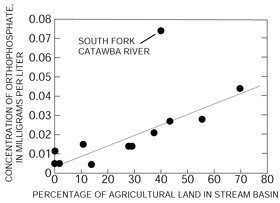 |
| Figure 11. The concentration of orthophosphate in streams is directly related to the percentage of agricultural land in the stream basin except for the South Fork Catawba River. |
For all the streams in the study unit, except in the South Fork Catawba River, there is a strong relation between orthophosphate (the predominant form of dissolved phosphorus in streams) concentrations and the percentage of agricultural land in the basins sampled (fig. 11). This relation most likely results from the runoff of phosphate-containing chemical fertilizer and manure from agricultural lands. The relation generally is not influenced by municipal waste-water discharges because phosphate-containing detergents have been banned for domestic use in the Santee Basin since the late 1990s (Litke, 1999).
The South Fork Catawba River has much higher concentrations of orthophosphate than would be predicted from the amount of agricultural land in the basin (fig. 11). This may result from a lack of a phosphorus ban on industrial users. The South Fork Catawba River Basin contains a large concentration of industries that use phosphate detergents, which are a potential source for the high orthophosphate levels in the South Fork Catawba River (Lindsey and Lewis, 1994).
Water-Supply Aquifers Rarely Exceeded Drinking-Water Standards for Nitrate
With the exception of nitrate, most nutrient concentrations in ground water in the Santee Basin were low. This is fairly typical of ground water in which most forms of nitrogen and phosphorus are negligible (Nolan and Stoner, 2000).
 |
| Figure 12. Nitrate concentrations in shallow ground water in agricultural areas were higher than those in urban areas and in major aquifers. |
Nitrate concentrations exceeded the USEPA (1996) drinking-water standard of 10 mg/L in 14 of the 150 wells sampled. Drinking water containing concentrations of nitrate above the standard can result in methemoglobinemia, a life-threatening illness. All but two of the wells that exceeded the standard were located in the shallow aquifer beneath agricultural land in the Coastal Plain. In fact, wells in the agricultural land-use study had the highest concentrations of nitrate overall, with concentrations up to 23 mg/L and a median concentration about double the national NAWQA median for agricultural land use (fig.12). Although the shallow aquifer generally is not used for drinking-water supplies, the potential for movement of nitrate-enriched water to deeper aquifers used for water supply is a cause for concern. Wells beneath urban land had lower median concentrations of nitrate than wells in agricultural lands and were lower than the national NAWQA median for urban land use.
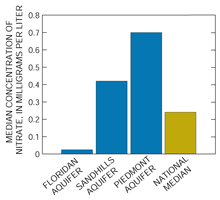 |
| Figure 13. The Piedmont and Sandhills aquifers had higher median nitrate concentrations than the Floridan aquifer. |
Nitrate concentrations measured in the three drinking-water supply aquifers sampled in the Santee Basin were variable. The Piedmont had the highest nitrate concentrations, followed by the Sandhills and Floridan aquifers (fig. 13). Only two wells exceeded the drinking-water standard for nitrate, one each in the Piedmont and Sandhills aquifers. With the exception of these two wells, most concentrations measured were well within the standard. One of the wells with a concentration above the standard was an irrigation well located in the middle of a corn and soybean field; the other was adjacent to a golf course. These results suggest that most wells in these three aquifers are safe from high levels of nitrate, but some concern is justified for wells located near areas with high fertilizer use.
The higher nitrate concentrations in the Piedmont and Sandhills aquifers are related to the lack of confinement for these aquifers, which readily allows the downward movement of surficial contaminants. Water in these aquifers often has high dissolved oxygen concentrations, which prevents denitrification (the removal of nitrate by conversion to nitrogen gas). By comparison, the Floridan aquifer has the lowest nitrate concentrations because it is confined, meaning little water moves vertically into the aquifer, and it has little dissolved oxygen, a condition which can promote denitrification.
Nitrate in Ground Water Can Affect Nitrate Concentrations in Streams
|
|
| Water levels were measured simultaneously in Cow Castle Creek and at multiple depths in the aquifer below the creek. Under most streamflow conditions, water from the aquifer was moving upward into the creek. |
Local conditions can strongly affect the nitrogen concentrations in ground water and how much nitrate discharges from ground water to surface water. A study of the transport of nitrate in ground water was conducted at an agricultural site adjacent to Cow Castle Creek, S.C. (fig. 14). At this site, ground water beneath a corn field had concentrations of nitrate more than 28 mg/L, nearly three times the drinking-water standard. Along the ground-water flow path, nitrate concentrations decreased to less than 5 mg/L.
Directly below the streambed, nitrate concentrations were above 4 mg/L. However, as ground water moves upward to the stream, it passes through an organic-rich zone containing little dissolved oxygen. Denitrification occurring in this zone results in water with a nitrate concentration of only 0.4 mg/L.
Denitrification may not always be effective in removing nitrate at all locations where ground water discharges to Cow Castle Creek. This is evidenced by the high concentrations of nitrate measured in Cow Castle Creek during low flow when most streamflow is attributed to ground-water discharge.
 |
| Figure 14. Concentrations of nitrate are reduced through denitrification as ground water flows to Cow Castle Creek. Typical wells used for water supply in this area are greater than 100 feet deep. Nitrate concentrations at that depth generally are not above drinking-water standards. |
|
| Table of Contents || Previous Section || Next Section || Glossary U.S. Geological Survey Circular 1206 Suggested citation:
|

